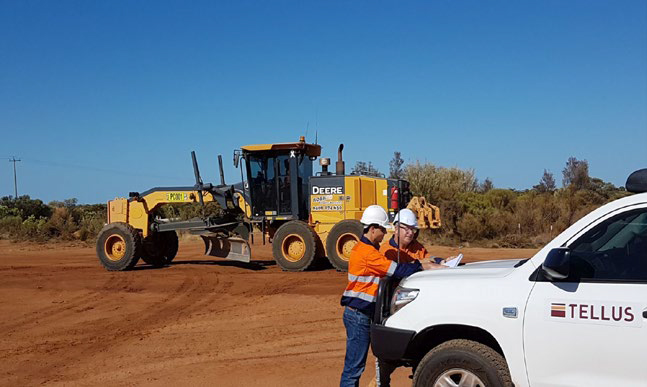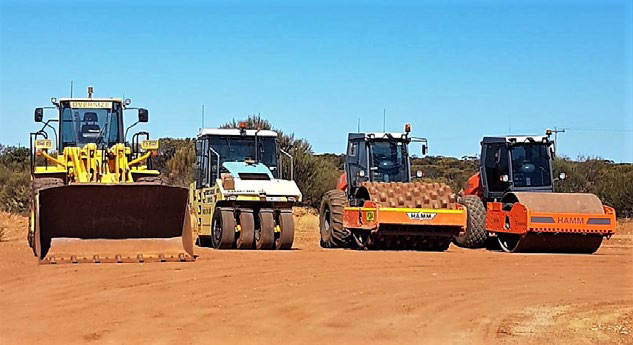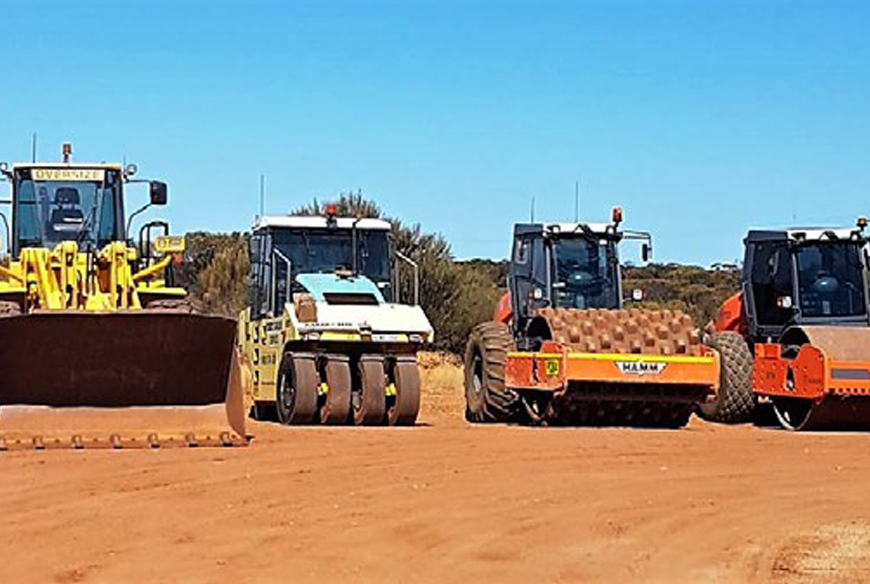Contractors break ground on Sandy Ridge Facility’s stage one enabling works
- Contractors mobilised to site and break ground on Stage one enabling works
- Stage two facility build expected in early June 2019, aligning with regulatory approvals
- On-site waste acceptance scheduled October 2019 and site fully operational March 2020
Tellus Holdings Ltd (Tellus) is pleased to announce that following securing recent major approvals, financial close and the completion of the first drawdown that the contractors have already mobilised to site and have broken ground on the Stage one enabling works for its Sandy Ridge Facility located within the Goldfields Region of Western Australia (WA).
Tellus has issued a Notice to Proceed for the engineering procurement and construction (“EPC”) contract to GR Engineering Services Ltd and the project management consultant (“PMC”) Turner & Townsend to begin Stage one enabling works.
The Stage one enabling works includes engineering, design and long lead procurement activities including the manufacturing of the cell air dome foundation blocks and the offsite civil works.
Fig 1: Sandy Ridge layout (artist impression)

The civils contractor has already mobilised to site for safety and improved access upgrades and maintainance of the following under existing approvals:
- Great Eastern Highway intersection,
- Mt Walton road; and
- neighbouring Mt Dimer airstrip.
The staged works under contract align with regulatory approvals. The Stage two construction works includes engineering; procurement; construction; commissioning and performance testing of the Sandy Ridge facility site infrastructure.
Fig 2: Stage one enabling works commenced on the intersection of the Great Eastern Highway and the Mt Walton road

This includes mining of the first open cut kaolin pit (waste cell), container yards, site warehouses and offices, roads, a 71-room accommodation village and associated services and utilities.
The facility commissioning and full operations are scheduled for March 2020. The project development plan targets the acceptance of surface storage of waste materials to commence from early October 2019.
Fig 3: Improving acess & safety of Mt Walton road

About Tellus Holdings:
Tellus Holdings Ltd (“Tellus”) mission is to contribute towards a cleaner Australia by developing a portfolio of geological repositories that provide waste storage, recovery and permanent isolation solutions plus complementary salt and clay products to our clients.
This dual revenue model involves mining the commodities kaolin clay and rock salt in thick dry remote beds which creates world’s best practice geological repositories. The voids created by mining are then used to store equipment, archives and waste using a multi- barrier system as part of an integrated safety case. Tellus plans to permanently isolate hazardous waste using environmentally sound management (ESM) principles that protect the environment and human health.
Tellus also uses long-term storage that supports the circular economy by placing like-with-like materials for operational safety reasons and to create opportunities for the future recovery of valuable materials. Tellus’ business model mirrors overseas solutions operating in the UK, Europe and North America.
Tellus is developing the proposed Sandy Ridge facility in Western Australia (WA) and the proposed Chandler facility in the Northern Territory (NT). Both Sandy Ridge and Chandler were awarded Major Project Facilitation Service by the Australian Government and Chandler was awarded Major Project Status by the NT Government.
About Sandy Ridge:
Tellus is proposing to develop the Sandy Ridge facility, Australia’s first dual open-cut kaolin mine and arid near-surface geological waste repository in a 70-million-year-old kaolin clay bed with a 25-year operating licence, which is located 240 kilometres by road west north west of Kalgoorlie. The proposal would involve mining up to 290,000 tpa of kaolin clay and receiving up to 100,000 tpa of Class IV and V waste (“hazardous waste”) at the facility gate over 25 years. Only wastes generated within WA, other Australian States and Territories, and the Australian Exclusive Economic Zone can be accepted, subject to meeting the facility’s waste acceptance criteria.
About kaolin clay:
The kaolin to be mined is suitable for applications in the ceramics, paint and environmental remediation industries.
About hazardous waste
In its simplest definition, hazardous waste is waste that can harm the environment or human health and therefore should be removed from the biosphere where it can pose a threat. Australia is one of the highest emitters of hazardous waste per capita. Approximately 10% of Australian reported waste is classified as hazardous (by volume). Annual hazardous waste production in 2015 was approx. 45 M tpa, with only 5.3 M tpa reported and entering the waste market. The legacy hazardous waste stockpile in Australia is 1 Billion tonnes and growing. There is insufficient infrastructure at competitive price points to permanently solve the problem or recover valuable materials. Tellus Sandy Ridge facility will be licenced to accept Class IV (Secure Landfill) and Class V (Intractable Landfill) waste from all of Australia. The majority is chemical waste from a broad spectrum of industrial sectors, including mining, oil and gas, contaminated site remediation, and utilities, along with a small amount of low level (LLW) Naturally Occurring Radioactive Materials (NORM) and low level Disused Sealed Radioactive Sources (DSRS). Tellus’ Sandy Ridge facility will not accept any nuclear waste, or waste streams falling under intermediate (ILW) or high level (HLW) radioactive waste designations.
About geological repositories:
Geological repositories are facilities that can offer long term storage, treatment, recovery and permanent isolation of equipment and hazardous waste services. Geological repositories provide the highest level of containment for hazardous waste (chemical waste) and low-level radioactive waste (LLW) isolating them from the biosphere over geological time. This is achieved through a combination of carefully selected active (man made engineered barriers) and passive control measures (natural barriers). This is known as a multi-barrier system. Tellus’ safety case relies on multiple fail-safe mechanisms but the best barrier of them all is the passive control mechanism. In other words, the carefully selected site and host rock which does not require ongoing monitoring is the fundamental property of geological waste repositories, which remain passively safe through geological time.
For further information:
Visit: www.tellusholdings.com.au or contact:
Jonathan Fisher
CFO/ Company Secretary
Tel: +61 (0)2 8257 3395 E-mail: companysec@tellusholdings.com

